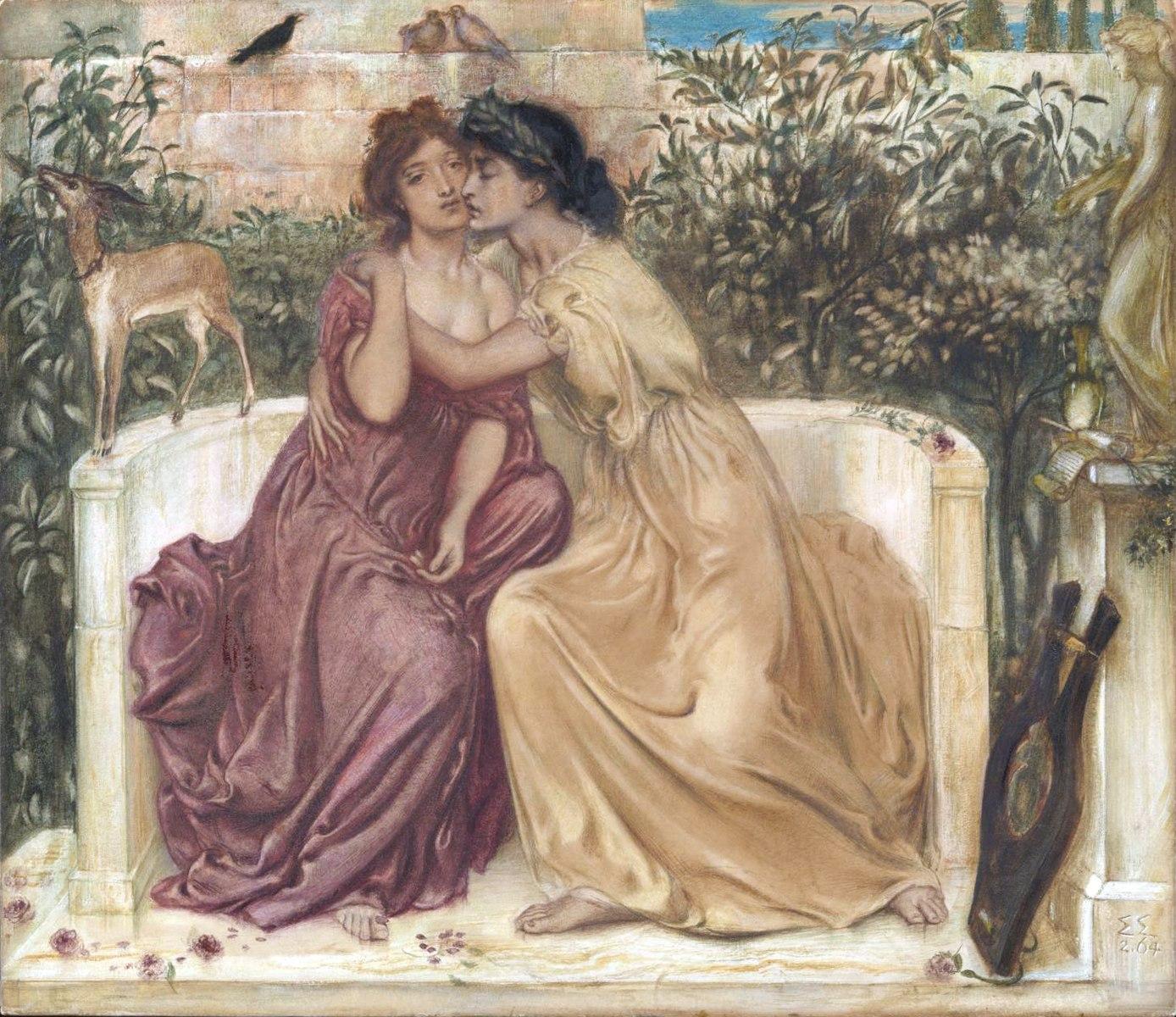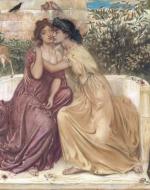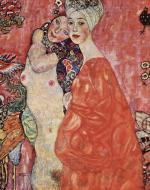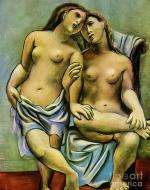Created by Ian Meyers on Mon, 02/26/2024 - 11:21
Description:
Display Explanation
The room in which these three paintings will be displayed will not be overly complex or open. It will be a small room, giving the viewers some encouragement to go in one at a time and immerse themselves in the themes of intimacy in this installation. Warm lighting and off-white walls should further give viewers a sense of comfort walking into this room. The closeness of the space, warm lighting, and comfortable tone of the installation will help viewers better understand the feeling invoked by these images depicting the once taboo, but nevertheless passionate, nature of homosexual love. Coming in from the doorway, the painting on the back wall is Sappho and Erinna. It will be hung on the wall, with nothing else surrounding it. The painting itself is already extremely small, and ties to the idea that this is the first stage of homosexual love between women; feeling the need to hide it. I would like a dim light to shine over this piece, driving the point home that this is an almost lowkey depiction of love. But it is there.
Sappho’s face looks toward the left, which, in theory, should guide the viewer to facing the left wall, which houses the next painting. Chronologically and thematically speaking, the painting on the left wall comes after the lowkey love of Sappho and Erinna. The painting is Klimt’s Girlfriends. It is a bigger painting than Sappho and is also in a different orientation. Because of this, the canvas naturally takes up more wall space this way, commanding the attention of the viewer. The light above this one is brighter than that of Sappho’s, highlighting the intensity of this image compared to the previous.
The gaze of the two women faces the right and final wall of the room. This wall holds Picasso’s Two Nude Women. I could not find any information on the actual size of this piece, so for the purpose of this installation and symmetry, we will pretend it is around the same size as Girlfriends. This painting will have no dedicated light to it. The dim nature shows that the fiery passion of love has diminished in this piece, but that does not mean the women depicted are not in love. They are, of course, but not to the point where they need to hide it or flaunt it like as depicted in Sappho and Girlfriends. The gaze of the woman on the right points back towards Sappho, so if the viewer wants to go through the installation again, they can. The other woman faces the exit, where viewers can leave if they wish, hopefully taking with them a new understanding of homosexual love.
The positioning of these paintings will be centered on their respective walls. Sappho should be perfectly centered, so Erinna can look at viewers right when they walk in. The positioning of Girlfriends and Two Nude Women should be centered as well, but their height from the floor should be adjusted so their gazes face each other. There will be no music or any other outside noise intruding on the installation, to highlight the closeness of intimacy between the women, and, in turn, the viewer.
Installation Note
The purpose of this installation is to depict the progressive evolution of homosexuality in art pieces, particularly love between women. From hiding, to flaunting, to being content.
The first art piece was painted in 1864 by Simeon Solomon, named Sappho and Erinna in a Garden at Myteline. In this painting, we see Sappho (on the right) and Erinna (on the left) embracing each other and touching faces. Both women are fully clothed, save for Erinna’s breast possibly being exposed behind Sappho’s arm. This is a fairly discreet depiction of homosexual love; there is no kiss or nudity that we can see. The fact that these women are in a garden can let us assume this is perhaps a new experience for them. Gardens, of course, housing flowers which could symbolize love. Animals are also present, two birds behind the women also nestled together with a black crow watching them. This could perhaps resemble that the women know that by 1864 standards, their intimacy could be perceived as wrong if seen by the wrong person (a black crow). The deer, possibly symbolizing Artemis, could harken to the fact that she belonged to a tight-knit group of solely women. Perhaps Sappho and Erinna are also in a group of women that were intimately connected. Erinna is facing us with a calm look on her face. Although she knows this is something that ought to be hidden, she is happy that at least one person, the viewer, is able to see the kind of love she desires. Sappho and Erinna feel awakened, safe, and at peace in the garden...but they are in a secluded area for a reason.
Sappho’s face points us towards the next piece, Girlfriends, painted in the late 1910s. This piece shows us two women in an embrace, one fully clothed and one fully naked. In contrast to the lowkey nature of Sappho and Erinna, this one does not shy away from the fact that these two are romantically involved. Now, both women are looking at us, almost flaunting their relationship and challenging us to see if there is something taboo about their love. Their faces express that they are in love and want the world to know. No more hiding in secluded gardens or facing away from people, this is who we are and what we do. Similarly to Sappho and Erinna, flowers and birds surround the women, symbolizing love. The black crow is still present, but it is clear the women aren’t scared of it; they are relishing in it. The fiery colors as opposed to Sappho’s neutrals also lets us know of the passion behind this piece.
The gaze of the two women is looking at the final piece, Two Nude Women. Now, there is quite literally nothing to hide. These women are not looking at the viewer anymore, which isn’t an assumption that they are ashamed of their love, but that they are rather content. While the other two pieces offer an image of intimacy, this one offers one that is different. They are not trying to hide their love or show it to the world...Sappho and Girlfriends did that. Now that those messages are across, they can finally turn to what matters most; each other. Both women have their hair down and arms interlocked, and the cool colors reflect the calming feeing they have in each other’s presence. Not only that, but we no longer have any outside forces intruding in the background. These two women are in a blank room...their love for each other is not new. This is now their norm, their everyday activity. Their love isn’t something to hide or even something to flaunt, rather, it is what it is. Just love. The woman on the left looks towards the exit, and we can now leave the installation.
Overall, this installation showed the progression of homosexual love between women. While we can look at obvious things like clothing – or lack thereof – to explore this progression, we can also identify their gazes and backgrounds to tell the story. From the need to hide it, to the peace that they can love, to flaunting it to the world, and finally, truly loving each other through it all.
Works Cited
Klimt, Gustav. Girlfriends, or Two Women Friends. https://commons.wikimedia.org/wiki/File:Gustav_Klimt_021.jpg. Accessed 12 Feb 2024.
Picasso, Pablo. Two Nude Women II. 1920. https://pixels.com/featured/two-nude-women-ii-by-pablo-picasso-1920-pablo-picasso.html. Accessed 12 Feb 2024.
Solomon, Simeon. “Sappho and Erinna in a Garden at Mytilene.” Wikipedia, Wikimedia Foundation, https://commons.wikimedia.org/wiki/File:Sappho_and_Erinna_in_a_Garden_at_Mytilene.jpg. Accessed 12 Feb 2024.
Copyright:
Associated Place(s)
Featured in Exhibit:
Artist:
- Multiple Artists




